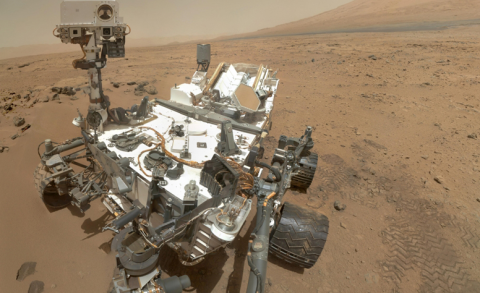Water on the Red Planet: NASA’s Curiosity rover discovers high amount of clay on Mars

Newstarget.com
NASA announced that Curiosity, the rover that has explored the Martian landscape since 2012, has discovered an exceptionally large clay deposit. Clay has been found on the Martian surface before, but never in such large quantities.
The amazing discovery was made at the aptly named “clay-bearing unit,” a region at the base of Mount Sharp, a 3.4 mile-high Martian mountain. There, Curiosity drilled and took samples from two rock targets called “Aberlady” and “Kilmarie.”
Curiosity analyzed the clay samples in its internal laboratory instrument CheMin (Chemistry and Mineralogy). It also found traces of hematite, an iron oxide that was found in abundance in the north of Aberlady and Kilmarie, at Vera Rubin Ridge.
Orbiters — space probes orbiting a planet — that were scanning Mars were the first to find evidence of clay at Mount Sharp. Curiosity’s inspection of rock samples confirmed their findings.
According to NASA, what these new findings mean for the Gale Crater region, the region of Mars where Curiosity and Mount Sharp are located, is still up for debate. There is evidence suggesting that the rocks formed as layers of mud around ancient lakes. NASA scientists state that water may have interacted with sediment over time, leaving an abundance of clay in the rocks.
Water is the key
Gale Crater was chosen as Curiosity’s landing site because scientists believed it was a dried-up lake bed. The discovery of clay deposits is crucial as it lends more evidence to their hypothesis; it helps paint an even clearer picture of whether or not this region used to be a vast salty lake.
Support our mission and protect your health: Organic Seeds of Life combines Red Raspberry Seed Power, Black Cumin Seed Power and Red Grape Seed Powder into the most potent nutrient-rich supplemental superfood powder you've ever experienced. Loaded with flavonoids, antioxidants, anthocyanins, OPCs, ALA and a vast array of vital nutrients. Learn more here.
Curiosity collected rock and soil samples that were analyzed by researchers from the California Institute of Technology. These samples were found to have a diverse range of salts that haven’t been observed in other rocks collected on Mars.
The Caltech team proposed that the sulfates found on the rocks were from evaporated water, which might indicate the existence of brine pools – extremely salty pools where ancient Martian microorganisms could have lived. (Related: Does Mars have an active groundwater system? Scientists say YES.)
This has led NASA scientists and the Caltech team to believe that Gale Crater was once a saltwater lake some 3.3 to 3.7 billion years ago.
Life is the mission
The evidence supplied by Curiosity and the Caltech team are a starting point, but to get a concrete understanding of whether or not Mars harbored ancient microorganisms, more data is needed. That’s why the Mars 2020 rover is committed to finding evidence of life.
In a joint effort of both NASA and the European Space Agency (ESA), rock and soil samples from the surface of Mars will be brought back to Earth. When the Mars 2020 rover lands in the Jezero crater in February 2021, it will gather up to 38 individual samples, which it will keep safe until at least 2026. Afterward, a Mars Sample Retrieval Lander will be launched. This lander will have an ESA-built “fetch rover,” which will deploy as close as possible to the Mars 2020 landing site. Once the fetch rover lands, it will meet with the Mars 2020 rover, collect the samples, return to the lander and then get transferred to the Mars Ascent Vehicle (MAV).
Once on the MAV, the rocket will take off into the Martian orbit where it will remain adrift until an ESA-launched return vehicle comes to collect it and bring it back to Earth. If everything goes according to plan, Martian rock and soil samples will be landing in the deserts of Utah sometime in 2031, at the earliest.
Science and technology have come very far since the science fiction writer Jules Verne wrote a novel in the 19th century about reaching the moon. Now, humanity is perhaps only a few decades away from finding out whether ancient microorganisms used to live on Mars.
Sources include:



























